|
Our Pyle Line -
English
First Generation
John PYLE. Born 1606 in
Wiltshire, England/Wilts Co./Bishops Cannings. He
married Mary M. WITHERS, who was some relation to the Thomas WITHERS in the area, but as far as she being his daughter, is NOT proven. Born in Bishops Cannings, England. Mary M. died in Bishops
Cannings, Wilts Co., England in 1667, she was 73. Per Steve Thrasher of Louisville, KY: I just received a copy of the will of John Pyle (1606) who
died at Overton in Wiltshire. He was probably the son of the Edward Pyle
listed in the 1539 muster roll of Overton.
|
Transcription of John Pyle's will, pictured
below:
In the name of God Amen, the two and twentieth day of december, In the yeare
of our Lord God one thousand six hundred fiftie and one. I John Pyle of
Bishopps Cannings being sicke of bodie but sound and perfect in memorie
thankes bee to God doe make this my last Will and Testament in manner and
forme following, first I bequeth my soule unto the handes of Allmightie God
my only Saviour and Redeemer and my body to bee buried in the Church yard of
Bishopps Cannings. In primis ["First"] I give unto my Sonne John Tenne
poundes. Item I give unto my Sonne Robert Thirtie pound. Item I give unto my
Sonne Nicholas Thirtie pound. Also my Will is if my wife Marie [doe] chance
to marry I doe also give unto my Two younger sonnes Robert and Nicholas
Twentie poundes a peece more. Item all the rest of my goods and chattells
moveable and unmoveable I doe bequeath unto Mary my now wife whome I doe
appoint to bee my whole Executor. Item my Will is that my Executor shall
have one yeares libertie to pay my legacies & Moreover I doe appoint Thomas
Wythers the elder and Thomas Withers younger to bee my Overseers. John Pyle
his marke. Witnesses Thomas Withers Senior Thomas Withers Junior.
This Will was proved att London before the Right Worshipfull Sir Nathaniel
Brent knight Doctor of Lawes Master or Keeper of the Prerogative Court the
Nineteenth day of February In the yeare of our Lord God one thousand six
hundred fiftie and one by the oath of Marie the Relict and Executrix named
in the said Will to whome Administracion was committed of all and singuler
the goods, chattells and debts of the said deceased which any manner of
wayes concerne the said Will, Shee being first legallie sworne by vertue of
a commission in that behalfe well and truely to administer the same. /
Exemplum [copy]
_____________________
It is not clear why the date of the will itself was crossed out, leaving
someone else to add it ("December the 22th 1651") somewhat later on. The
date of probate is February 19, 1652 (new style). The new year in England at
the time began on March 25, so an adjustment has to be made for dates from
Jan 1 through March 24. Sometimes the year is given in the form 1651/52. I
should add that in the 17th century wills were normally in Latin, but from
1651 to 1660, during the Cromwell years, they were in English.
The term "my now wife" means "my present wife" and suggests that Pyle had
had at least one earlier wife.
Carl T. Berkhout
Professor
Department of English
University of Arizona |
This John Pyle is the originator of the Pyle family of Bishops Canning. The copy of John Pyle's will, below left, (and others on this page) was generously donated to me by Joe Pyle, of New York; Thanks Joe ! What a great piece of history to have.
The following were mentioned in his will:
wife-Elizabeth Pyle
son-Edward Pyle
son-Robert Pyle
son-John Pyle
son-Ambrose Pyle
son in law-Richard Brant
son in law-Ambrose Tarrant and 2 sons
son in law-Edward Ladd and one daughter
dau-Catherine Pyle (unmarried)
dau-Joane Pyle (unmarried)
dau-Agnes Pyle (unmarried)
Overseers-Thomas Phillips of Bromham, Thomas Crowell, Thomas Clifford
Steve Thrasher
I am
keeping notes on Steve's research here.
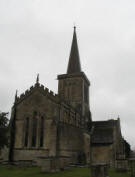 John Pile married Elizabeth ???? October 09,
1546 at Great Bedwyn, Wiltshire. Found no children in baptisms. John Pile married Elizabeth ???? October 09,
1546 at Great Bedwyn, Wiltshire. Found no children in baptisms.
This John Pile died in 1606 in Overton, Wiltshire. His will names his
children including Ambrose, Edward and John Pile/Pyle. All appear in Bishops
Canning, although the will does not mention them being of Bishops Canning.
Richard Pile, the younger, buried August 1585 at Great Bedwyn
Richard Pile, buried May 1589 at Great Bedwyn.
Richard Pile Sr. left a will at Great Bedwyn in 1589, naming children John
the elder, Edith, Agnes, John the younger and Richard. His will mentions his
friend Mr. Pile of Collingbourne Kingston.
It is beginning to appear that John Pile of Overton and Richard Pile of
Great Bedwyn are brothers and probably the sons of Edward Pile who was
listed at Overton in the 1539 muster rolls for Henry VIII.
I have collected lots of information on the Piles of Hampshire and Wiltshire
and am starting to try and sort all of it.
Steve Thrasher
Louisville, KY
Edward Pyle, son of John Pyle of Overton, was
62 in 1631 and
his brother, Robert Pyle, was 54.
Will of John Pyle of Overton - 1606 (Episcopal Consistory Court of Sarum)
Will of Elizabeth Pyle of Overton - 1618 (Archdeaconry of Wiltshire)
Will of Edward Pyle of Overton - 1634 (Episcopal Consistory Court of Sarum)
Will of Robert Pyle of Overton - 1667 (Archdeaconry of Wiltshire)
Steve Thrasher
Louisville, KY
Notes: Mary Withers made the following
bequests:
-
Son John, Five pounds, Son Robert, Ten pounds which he doe own me.
If satisfied with his legacy his father gave him at his decease, five
schillings more, other wise one shilling.
-
John Pyle, son of Nicholas Pyle, ten pounds and three pounds of
interest of the ten pounds to Robert Pyle, son of Nicholas.
-
Mary Pyle, daughter of Nicholas, five pounds, chest, brass pot and ring.
-
John Pyle, son of Nicholas, chest, brass pot, and bedstead.
-
Edith Pyle, daughter of Nicholas, three pounds.
-
Nicholas Pyle to have reminder of estate, and to be executor.
-
Overseers, John Pyle, my son, Will Weston of Bishops Cannings and Thomas
Withers of the same.
John Pyle
and
Mary Withers
had the following children:
|
i. |
John Pyle Born abt 1621;
b: ABT 1621 in Bishops Cannings, Wiltshire, England |
|
ii |
Robert Pyle Born abt 1623;
b: ABT 1623 in Bishops Cannings, Wiltshire, England
|
|
iii |
Nicholas Pyle (1625-1691) |
|
iv |
Thomas Pyle,
b. 1628, baptized, November 9, 1628. |
|
v |
Edward Pyle Born in
1632
|
|
vi. |
Marie Pyle b: 7 JUL 1639 in Bishops Cannings, Wiltshire, England,
buried, January 21, 1652. |
See a photo tour of the Bishop Cannings area by a Pyle descendant here.
Second Generation
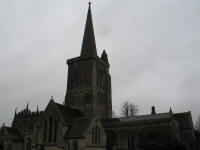 Nicholas
PYLE, SR. Born
on 12 Apr 1625 in Bishops Cannings, Wiltshire, Wilts, England, he was
baptized March 13, 1625. Nicholas died
on 26 Aug 1691, he was 66. He left a will dated February 9, 1690,
which was proved at Sarum, England September 21, 1691. On 26 Sep 1656 when Nicholas was 31,
he married Edith MUSPRATT, daughter of Thomas MUSPRATT & Edyth
BYFFEN. Born abt 1625 in Urchfont, Wiltshire,
England. Edith died on 10 Jun 1676, she was 51. Nicholas
PYLE, SR. Born
on 12 Apr 1625 in Bishops Cannings, Wiltshire, Wilts, England, he was
baptized March 13, 1625. Nicholas died
on 26 Aug 1691, he was 66. He left a will dated February 9, 1690,
which was proved at Sarum, England September 21, 1691. On 26 Sep 1656 when Nicholas was 31,
he married Edith MUSPRATT, daughter of Thomas MUSPRATT & Edyth
BYFFEN. Born abt 1625 in Urchfont, Wiltshire,
England. Edith died on 10 Jun 1676, she was 51.
It
is believed that Nicholas is buried at the church yard at Bishops Canning's.
In his will he made the following bequests:
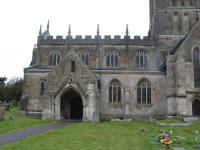
Son, John Pyle, five pounds, Daughter Mary Box, five pounds,
Son Robert Pyle, one shilling.
Son, William Pyle, all my chattles, except what I shall bequeath to my wife and allowing his sister Susannah house room for one room ?
Wife, ______ Pyle, forty shillings and ten pounds, on the bond, and as it
is lost, forty shillings more; goods and part of the house while she is a
widow.
Edith Painter, furniture, Daughter Susannah Pyle, and son Ralph and son
Samuel Pyle, remainder of estate.
Executors; Sons Ralph and Samuel Pyle and daughter Susannah Pyle.
Overseers; William Withers, yeomen, of Bishops Canning's, Arthur Cooke, of
Canning's, tailor.
Christening: 13 MAR 1625 Bishops Canning's,
Wiltshire, England
Burial: 26 AUG 1691 Bishops Canning's, Wiltshire, England
Probate: 21 SEP 1691 Sarum, Wiltshire, England
They had the
following children:
|
i. |
Mary Pyle,
mentioned in father's will as Mary Box. |
|
ii. |
Edith Pyle,
mentioned as Edith Painter in father's will. |
|
iii. |
William Pyle |
|
iv. |
Susannah Pyle |
|
v. |
Samuel Pyle |
|
vi. |
John Pyle |
|
vii. |
Robert Pyle,
immigrated |
|
viii. |
Nicholas
Pyle (1666-1716), immigrated |
|
ix. |
Ralph
Pyle, immigrated, md. Elanor Rawlings |
Third Generation
 Nicholas
PYLE, Jr.
Born on 12 Aug 1666 in Wiltshire, Bishops Canning's, Wilts Co., England.
Nicholas died in Concord, Pennsylvania on 10 JAN 1716/17, he was 49.
In Sep 1688 when Nicholas was 22, he married Abigail BUSHELL, daughter of
Joseph BUSHELL & Sarah WEBB. Born in
1668 in Brinkworte, Wiltshire, England. Abigail died in Concord,
Pennsylvania on 11 Nov 1688, she was 20. Nicholas
PYLE, Jr.
Born on 12 Aug 1666 in Wiltshire, Bishops Canning's, Wilts Co., England.
Nicholas died in Concord, Pennsylvania on 10 JAN 1716/17, he was 49.
In Sep 1688 when Nicholas was 22, he married Abigail BUSHELL, daughter of
Joseph BUSHELL & Sarah WEBB. Born in
1668 in Brinkworte, Wiltshire, England. Abigail died in Concord,
Pennsylvania on 11 Nov 1688, she was 20.
Nicholas came to American in 1683 with his
brother Robert, and while their brother Ralph also came to America, it is
thought that he came at a later date, but all three brothers were among the
early settlers in the Pennsylvania Colony. It is family tradition that
Nicholas Pyle stood under the 'big elm tree' with William Penn the day that
Penn made the treaty with the Indians in June 1683.
On March 1, 1688
he purchased from John Palmer and wife, Mary, and John Hannum and wife,
Margery, (daughters of Robert Sudderly) 150 acres in Bethel, and settled
thereon, but on March 2, 1696, some eight years after his marriage to
Abigail, they conveyed this land to his brother Robert, and removed to
Concord township, at what is now Concordville, or Concord, Pennsylvania.
In 1699, Nicholas Pyle built a brick house in
Concord in which were held some of the early meetings of Friends, or
Quakers, in that vicinity, and this house was still being used as a dwelling
as late as 1883, and was torn down only a few years ago. Nicholas Pyle
was a devout Quaker.
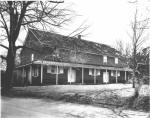 On 13 December 1697 John Mendenhall of Concord released to
Nicholas Newland and Nicholas Pyle both of Concord and George Pierce of Thornbury and Peter Dix of Birmingham, a tract of land bounded by the land
of John Mendenhall and Birmingham Road for a meeting house for the people
called Quakers, Birmingham Monthly Meeting? On 30 May 1711 there is a
deed mentioning that Nicholas Pyle had erected a water mill on a tract
bounded by Concord Street, land of Joseph Edwards, Mill Creek and land of
Nicholas Pyle, containing 7 acres. The deed was to Benjamin Mendenhall
mentioned in the paragraph above as father-in-law of Alice Bowater Pyle.
(Read about the Meeting House, pictured above,
here.) On 13 December 1697 John Mendenhall of Concord released to
Nicholas Newland and Nicholas Pyle both of Concord and George Pierce of Thornbury and Peter Dix of Birmingham, a tract of land bounded by the land
of John Mendenhall and Birmingham Road for a meeting house for the people
called Quakers, Birmingham Monthly Meeting? On 30 May 1711 there is a
deed mentioning that Nicholas Pyle had erected a water mill on a tract
bounded by Concord Street, land of Joseph Edwards, Mill Creek and land of
Nicholas Pyle, containing 7 acres. The deed was to Benjamin Mendenhall
mentioned in the paragraph above as father-in-law of Alice Bowater Pyle.
(Read about the Meeting House, pictured above,
here.)
Nicholas Pyle from Chester
(Concord) Mo. Mtg., Pa. 13 Dec 1713 a certificate in order to marry Ann
Webb, of Philadelphia Mo. Mtg. Original on file. At Phila., 1 mo. 27, 1713.
Death: AFT 18 DEC 1716 in Chester
County, Pennsylvania
Christening: 12 AUG 1666 Bishops Cannings, Wiltshire, England
Burial: Concord Meeting Burying Ground, Concord, Pennsylvania
Will: 6 OCT 1715 Chester County, Pennsylvania.
|

|

|

|
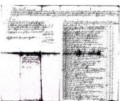
|
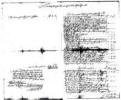
|
|
Nicholas Pyle
Executor's Note |
Nicholas Pyle, Will
Page 1 |
Nicholas Pyle, Will
Page 2 |
Nicholas Pyle
Account 1 |
Nicholas Pyle
Account 2 |
|
The above wills were copied by Joe Pyle from New York, Thanks Joe ! |
Nicholas
Pyle and Abigail Bushell had the
following children:
|
i. |
Mary Pyle Born on 23
Jun 1689.
Married Joseph Sharp, at
Concord Meeting September 4, 1713. |
|
ii. |
Edith Pyle,
(1694-)
who married Nicholas Newlin, son of Nathaniel and Mary Mendenhall Newlin,
8/1715 at Concord Meeting House. They also had a son, Nicholas Pyle,
Jr., who married Sarah Worrilaw 10/7/1721 at Concord Meeting House.
Nicholas and Sarah Worrilaw Pyle had a daughter Mary Pyle who married John
Newlin, Jr., son of John and Mary Woodward Newlin, on 9/13/1745 at
Concord Meeting House. John and Mary Pyle Newlin went to North
Carolina. |
|
iii. |
Nicholas Pyle (1697-)
md Sarah Worrilow. |
|
iv. |
Samuel Dr. Pyle (1700-1749) |
|
v |
James Pyle, born October 2, 1703 |
|
vi |
Joseph Pyle, born February 15, 1706 |
|
vii |
Sarah Pyle, under 16 in 1715. |
Fourth Generation
Dr. Samuel
PYLE,
born on 21 Dec 1700 in Concord, Pennsylvania. Samuel died in
Pennsylvania in 1749, he was 48.
In 1721 when Samuel Dr. was 20, he married UNKNOWN.
It is now doubtful that
neither Sarah Pringle or Sarah Owen was
the wife of our Samuel Pyle. If anyone has proof otherwise, please
contact me. The old brick house in which he was born was
still being used as a dwelling in 1883 by the family of Benjamin W. Passmore.
This house was built by Nicholas Pyle, the father of Samuel, in 1699.
Some people claim that Samuel may
have been married in England while he was attending college there.
This surmise may be correct, as he was apparently only twenty years old at
the tie of his marriage, and we know that he did attend medical college in
England. It was typical in those days for wealthy planters to send
their sons to England to be educated.
On his return to Pennsylvania
from England Dr. Samuel Pyle and his wife Sarah settled in Kennett
where he had a distinguished career as a physician. The will of
Nicholas Pyle shows that son Samuel inherited '257 acres in Kennett' from
his father's estate.
Dr. Samuel Pyle was a Quaker but
the records say that he was married in 1721 "out of meeting". So
his wife was obviously not a Quaker...
Samuel had a sister named Mary.
Joseph Sharp, husband of Mary, left a will in which he expressed a desire
that "Samuel Pyle should have the care of his son, Samuel Sharp, until he
was 21."
Samuel Pyle and Unknown had the
following children:
|
i. |
Nicholas Pyle - born
February 8, 1722.
* From the
History of Christian County, Kentucky by Perrin (page 170) comes
this about Nicholas Pyle:
Samuel Younglove, Joseph Meacham and Joseph Casky (the original
founder of Casky Precinct) were Revolutionary soldiers, and moved to
the county at an early day. There were doubtless many others who
came about the same time, but their names have not been obtained.
Several families of Tories also came to the county, but did not meet
with much sympathy or countenance from the citizens at large. Among
the number was Nicholas Pyle, who was the son of Col. Pyle of the
British Army. He was very much depressed by the unfriendliness of
his neighbors, and lived a life of comparative retirement. On the
breaking out of the war of 1812 he was one of the first to volunteer
in the defense of that country against which he had before fought.
He was with Jackson at the battle of New Orleans, and deported
himself so gallantly as to compel the admiration of all who knew
him. Afterward his old neighbors took him into their favor, and were
wont to say: "Nick Pyle is a gallant fellow, and has redeemed
himself.
And these Records Pertain to this Nicholas Pyle:
The South Carolina Magazine of Ancestral Research
SCMAR, Volume VI
Number 2, Spring, 1978
Pendleton County Court Minutes (Continued from Vol. 6, p.22)
SCMAR, Vol. VI, Spring 1978, No. 2, p.81
Nicholas Pyle vs Thomas Roberts and Wm. Roberts Ordered a Capias do
issue returnable before any Magistrate to compel said Parties to
enter into special Bail for the sum of Twenty-five pounds sterling
with interest since the first day of October last.
The South Carolina Magazine of Ancestral Research
SCMAR, Volume VI
Number 2, Spring, 1978
Pendleton County Court Minutes (Continued from Vol. 6, p.22)
SCMAR, Vol. VI, Spring 1978, No. 2, p.95
Nicholas Pyle vs Thos Roberts Made up.
SCMAR, Vol. VIII, Spring 1980, No. 2, p.93
Nicholas Pyle vs Thomas Roberts, Wm. Roberts. Debt by note 25 |
|
ii. |
Col John
Pyle, M.D. (1723-1804); went to England, Oxford Shire,
to study medicine and came back to the US around 1744. Married
Sarah Baldwin, June 1744. |
|
iii. |
Edith Pyle, born March
2, 1726, married _______ Harlan. |
|
iv. |
Abigail Pyle, born April
10, 1728 |
|
v. |
Sarah Pyle, Born January
15, 1730 |
|
vi. |
Mary Pyle, born February
4, 1731, died November 13, 1732 |
|
vii. |
Ann Pyle, born January
13, 1733, md. John Hollingsworth May 20, 1752. |
|
viii. |
Samuel Pyle, born
November 17, 1736 |
|
ix. |
William Pyle, born June
18, 1740, d. November 7, 1742. |
|
x. |
Betty Pyle, born
February 23, 1742. |
|
A note I received from another
researcher that has worked the line and made the following discovery.
If there is anyone out there that knows any thing more on this information
and what the correct information may be, please e-mail me or Bob.
Thanks.
I see from my sent items folder that I
sent an email to you in November of 2000 asking if you had any
evidence concerning the claim that Sarah, the wife of Dr. Samuel
Pyle, was a daughter of Joshua Owen. I thought that you might be
interested in knowing that I've thoroughly investigated this claim
and there is no evidence to support it, and in fact, evidence
proves it isn't true; The source of the "information" that
Sarah Pyle was a daughter of Joshua Owen is one of the lineage
books of The Order of the Crown of Charlemagne.
Since I could find
no evidence to support the claim, I wrote to the organization and
asked them if they would send me a copy of the membership papers
of the person who joined on this lineage, and fortunately, they
did. These membership papers dated to 1962 or thereabouts. None of
the "evidence" cited, when checked, even mentioned Samuel Pyle,
much less proved that Joshua Owen had a daughter named Sarah. In
fact, the one piece of evidence cited anywhere (not even mentioned
in these lineage papers) to suggest that he had a daughter named
Sarah proves that she wasn't Samuel Pyle's wife, since it refers
to her as Sarah Owen when she would have been Sarah Pyle: The History of the Shinn Family
in Europe and America by Josiah H. Shinn; On 3/17/1738 Rowland Owen, son
of Joshua, and Prudence Powell, daughter of John, were married
in presence of Joshua, Mary and Sarah Owen and thirty-six
others.
This is the only bit of evidence to suggest that there actually was a Sarah
Owen who might have been a daughter of Joshua Owen- this
certainly doesn't prove it. Added to that is the fact that
Samuel and Sarah Pyle had been married for many years
before 1738 and had a number of children by then. Upon notifying the organization
of these facts its current genealogist apparently made his own
investigation and agreed there is "problem" with this line. In
short, the whole thing was a fraud on somebody's part. Samuel's wife was also not Sarah
Pringle. That was a different Samuel Pyle. The marriage date of
Samuel Pyle and Sarah Pringle was recorded in the Quaker meeting
records, and was years after Dr. Samuel Pyle and his wife Sarah
were married.
Bob Cabbage Belleville, IL
It's not merely a case of there being no evidence
that Dr. Samuel's wife Sarah was either Owen or Pringle, but that
what evidence there is ABSOLUTELY PROVES that she was neither
Sarah Owen nor Sarah Pringle.
1) The man who made the claim for
Owen was faking a line to get into The Order of the Crown of
Charlemagne and it's obvious that the people who were entrusted
with verifying the line simply rubber-stamped the
application because the wife of the prospective member was high in
that organization.
There is ONE and ONLY one piece of evidence
that Joshua Owen may have even had a daughter named Sarah and it
proves that she wasn't Sarah Pyle since it specifically calls her
Sarah Owen many years after Dr. Samuel and his wife were married.
2) The people who are saying that she was Sarah Pringle are again
ignoring the dates. The marriage date of THAT Samuel Pyle and
Sarah Pringle is recorded in the Kennett meeting records, and it
took place many years after the marriage of DR. Samuel and his
wife Sarah.
In fact, Sarah Pringle was still across the
water when Dr. Samuel and his Sarah were married. That fact
is also proven by the meeting records, which mention when Sarah
Pringle was received into the Kennett meeting from Ireland. The
Samuel Pyle who married Sarah Pringle was the son of Jacob Pyle
and Alice Bowater, a fact well-known to his descendants.
In short,
the family identity of Sarah, the wife of Dr. Samuel Pyle, has yet
to be established- but let's not give up hope. It seems that the
will records won't establish who she is, but I don't know that
anyone's has ever gone through the land records seeking her identity.
There may still be some hope. Of course, if it's true, as some
people have speculated, that Samuel married in England, who knows
what might turn up? Dr. Samuel and Sarah's approximate marriage
date is established by the fact that Samuel was called before the
meeting for marrying out of meeting. Most people interpret that to
mean he married a non-Quaker, but I also wonder if it could just
mean that he married someone who wasn't a member of HIS meeting
and that they were married without going through the process that
Quakers had to go through to get married- i.e., both parties had
to go through some process of being interviewed and lectured by
members of the meeting to determine if they were fit for marriage.
It's obvious that if Sarah wasn't a Quaker, she became one, since
the meeting records record the births of her children.
Sincerely, Bob C.
|
|
Some Pyle Land Grants, Christian County, Kentucky
|
Pyle, Abner |
350 |
6 |
37 |
8/12/1806 |
Christian |
Little R |
|
Pyle, Abner |
400 |
10 |
300 |
2/3/1803 |
Christian |
Little R |
|
Pyle, Abner |
400 |
15 |
285 |
7/17/1803 |
Christian |
Little R |
|
Pyle, Dr. Wm |
200 |
7 |
32 |
5/27/1803 |
Christian |
Little R |
|
Pyle, Dr. Wm |
320 |
12 |
379 |
8/22/1803 |
Christian |
Little R |
|
Pyle, Jno |
200 |
8 |
416 |
7/21/1800 |
Christian |
Rock Lick Fk |
|
Pyle, Jno |
400 |
12 |
64 |
8/29/1807 |
Christian |
E Fork Little R |
|
Pyle, Jno, Jr |
400 |
5 |
80 |
1/27/1803 |
Christian |
Little R |
|
Pyle, Jno, Jr |
400 |
8 |
462 |
1/27/1803 |
Christian |
Little R |
|
Pyle, Jno, Jr. |
325 |
19 |
221 |
8/28/1812 |
Christian |
Little R |
|
Pyle, Jno, Jr. |
100 |
19 |
291 |
7/30/1803 |
Christian |
Tradewater None |
|
Pyle, Nancy |
395 |
10 |
312 |
10/19/1807 |
Christian |
Little R |
|
Pyle, Nicholas |
200 |
5 |
522 |
3/29/1799 |
Christian |
Little R |
|
Pyle, Nicholas |
400 |
12 |
380 |
8/28/1807 |
Christian |
E Fk Little R |
|
Pyle, Nicholas, Sr |
200 |
2 |
53 |
3/29/1799 |
Christian |
Little R |
|
Pyle, Samuel |
400 |
10 |
316 |
8/28/1807 |
Christian |
E Fk Little R |
|
Pyle, Samuel |
200 |
17 |
308 |
6/29/1799 |
Christian |
Little R |
|
Pyle, Thos |
400 |
12 |
381 |
8/29/1807 |
Christian |
E Fk Little R |
|
Pyle, Wm |
400 |
23 |
337 |
8/6/1803 |
Christian |
None |
|
Pyle, Wm, Jr |
200 |
6 |
83 |
3/19/1799 |
Christian |
Little R |
|
Pyle, Wm, Jr |
200 |
6 |
78 |
3/21/1799 |
Christian |
Little R |
|
Pyle, Wm, Jr |
200 |
8 |
436 |
5/27/1803 |
Christian |
Little R |
|
Pyle, Wm, Jr |
400 |
18 |
162 |
5/27/1803 |
Christian |
Little R |
|
Fifth Generation
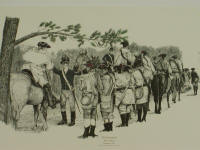
John
PYLE, Dr. Born
on 8 Apr 1723 in
Concord, Chester,
Pennsylvania. John died in Chatham, North Carolina on 1 Jan 1804, he was
80. On 4 Jun 1744 when John was 21, he married Sarah BALDWIN,
daughter of John BALDWIN, JR. & Sarah CLOUD or Hannah?, in Pennsylvania? Born in
1726 in Hartford Co., Maryland. Sarah died bef 1790, she was 64.
|
Here is John Pyle's Will as recorded
in Chatham County, North Carolina:
Chatham
Co., Record of Wills, Vol. A, pg. 187 (50)
N.C. State Archives film # C.022.80001
In the Name of God, Amen. That I John Pyle of the State of North
Carolina, Chatham County, Cain Creek Settlement, Being weak in body but
of perfect health & memory
calling to mind the mortality of my body & knowing that it is appointed
for all men once to die do make and ordain this my Last Will & Testament
that is to say Principally and first of all, I give and recommend my
soul Into the hand of Almighty God that gave it & my Body I recommend to
the Earth to be buried in decent Christian Burial at the discretion of
my Executors; nothing doubting but at the general resurrection I shall
receive the same by the mighty power of God & touching such worldly
Estate wherewith it hath pleased God to bless me in this life, I give
devise and dispose of the same in the following manner & form to wit.
All my just debts & funeral charges to be paid by my Executors hereafter
named that small piece of land whereon my buildings & meadow are what
I purchased from Valentine Hollingsworth I leave to be sold after my
decease with all my other immovable properties & all the moneys either
by Bond, Note or Book debt & the money arising from the above mentioned
sale to be equally divided between my son & my daughter.
First I give and bequeath to my sons Parlientor, Daniel/Samuel/???
John
Nicholas Wm & Jeheu Pyle each double that of a daughters. I have
named Sarah Lindley, Edith Steel, Ann
Steel & Susanah Justice.
If it should be that if any one of my sons or
daughters above named should be deceased before the sealing and signing
of this my last will & testament my will is that their part shall
equally be divided between his or her children & I do hereby disannul &
make void all other wills bequeathments, legacies heretofore made by me
& doth acknowledge this to be my last will and testament & I do
constitute James Newlin & Thomas Lindley to be my whole & sole
Executors of this my last will and testament in witness whereunto I
have set my hand & seal this thirteenth day of June In the year of our
Lord one thousand seven hundred & ninety nine.
John Pyle {Seal}
Signed Sealed Pronounced & declared
by the sd. John Pyle in his last
Will & testament in the presence
of us who in his presence and in the
presence of Each other have
here unto subscribed our names
John Newlin
Jacob Newlin
This is an
interesting read on John Pyle. |
|
I've recently gotten the
microfilm with the Case in Equity that is printed on page 1020
of the Pyle Book as John Pyle vs Thomas Lindley and James
Newland. On the file folder JOHN PYLE is typed on the label.
Once I got inside and looked at the handwritten document is was
clearly Jehu that brought the suit.
On paragraph 2 it has printed in
Pyle book . " Among his sons: John,
Samuel, Nicholas, William and John, your Orator." If this had
been John, he wouldn't have named himself twice.
On page 1021, 11th line down it
says, "...your Orator, his youngest son..." then in the 2nd
paragraph, same page, ..."And your Orator sheweth that at the
time of execution of said Deed he was an infant under the age of
twenty-one years, to wit of about sixteen years of age and then
living with his father..."
This was obviously not John but Jehu. Also notice he named
Samuel before Nicholas. The Pyle book has Nicholas born 1748 and
Samuel 1758. It is widely written that Nicholas volunteered for
the War of 1812 and fought in the Battle of New Orleans which
was Dec, 1814 to Jan 1815. If Nicholas were born in 1748 he
would have been 66 or 67 at the battle.
If their dob were reversed it
would seem more likely Nicholas would have been born in 1758 and
56-57 at the battle and more credible.
It has been widely questioned why Col. John did not name Samuel
in his will. I've found that he died intestate in Greenville
County, SC in Nov 1787. Doris Haynes |
Greenville Co. SC Deed Book C 1791-1794, p. 36
Bill of Sale--20 Apr 1791
John Capehart to Robert Maxwell, both of Greenville County for 25 pounds
sold 6 cows and calves, 1 heiffer and yearling, 3 feather beds and pillows
and bolster, 1 pair of fire dogs, 7 chairs and 1 pine table, beadstead and
mattress, 8 pds of steel and 27 pds of iron, 2 bed cotts and laxy board and
small table, 1 grindstone, 3 indigo vatts and 33 poplar planks, 1 marble
slab, 63 head of hogs, 30 of which are grown. Signed: John Capehart -
Witnesses: Larkin Tarrant, John Pyle.
All of John and Sarah's children were born in Pennsylvania,
and about 1767 they all migrated to North Carolina and settled in the
northern part of Chatham County. It is presumed that they made
the first part of the journey by water, landing at Edenton and moving on
west by packhorse, for travel by land then was on foot and on horseback by
the Indiana trails, for it was some sixty years later that the first
railroad was operating on the American continent.
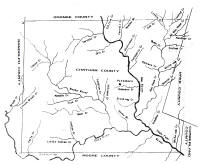 In Chatham County, Dr. John Pyle followed his chosen
profession of country doctor, ministered to his neighbors, and took an
active part in the affairs of the community. This part of the state
was known as the "back country" and it was relatively rural and isolated.
We are told that it was infested with horse thieves who took advantage of
the absence of the courts to rob the inhabitants. The frontiersmen
constituted their own courts which, like the later vigilantes of the West,
administered their own brand of Justice. Later it was necessary for
them to call upon the British troops for protection from those whom they had
thwarted, and this reliance upon British military protection resulted in
them being called Tories. This movement for self protection against
lawlessness had its beginnings in Orange County in 1766 by people who were
first known as the mob, but were later known as the Regulators. In Chatham County, Dr. John Pyle followed his chosen
profession of country doctor, ministered to his neighbors, and took an
active part in the affairs of the community. This part of the state
was known as the "back country" and it was relatively rural and isolated.
We are told that it was infested with horse thieves who took advantage of
the absence of the courts to rob the inhabitants. The frontiersmen
constituted their own courts which, like the later vigilantes of the West,
administered their own brand of Justice. Later it was necessary for
them to call upon the British troops for protection from those whom they had
thwarted, and this reliance upon British military protection resulted in
them being called Tories. This movement for self protection against
lawlessness had its beginnings in Orange County in 1766 by people who were
first known as the mob, but were later known as the Regulators.
As evidence that Dr. John Pyle and his son John, Jr. belonged
to the Regulators, we read in DeMond's history that Col. Ebenezer Folsom,
with headquarters at Cross Creek (Fayettesville) North Carolina on June 15,
1776, was given the task of capturing some of the escaped Regulators and he
captured John Pyle and his son John Jr. at the home of Farquard Campbell.
Dr. John Pyle did not consider himself a Tory, but a
Loyalist, and he was trying to preserve law and order against those whom, he
thought, were trying to destroy it. He considered himself a loyal
Englishman.
|
The Lindley's and
Pyle's were in Chatham county, North Carolina, as evidenced by these
deeds:
PYLE - Deed Bk. C -
1783-1786
pg. 6, Mar. 15, 1783
JOHN PYLE to
NICHOLAS PYLE, for 5 pds, specie, 220 acres, a part of the tract of
land whereon I now live on both sides of Little Cane Creek.
JOHN PYLE
Wit:
JAMES ALLEN
OTHNIEL MCPHERSON
PG. 331, Aug. 2, 1784
NICHOLAS PYLE and ANN his wife sell to JOSHUA HADLY, for 5
pds, specie, 75 acres, on both sides of Little Caine Creek, the land joins
Pyles line and it was part of a tract of land granted to JOSIAH ROGERS by
the state's authority dated Oct., 20, 1782, and conveyed to the sd
NICHOLAS PYLE by the
aforesaid JOSIAH ROGERS.
NICHOLAS PYLE
ANN(X) PYLE
Wit:
THOMAS LINDLY
THOMAS HOLLADAY
PG. 194, MAY 10, M 1784
ROGER GRIFFITH to JAMES NEWLAND of ORANGE CO., NC, whereas the 19th
section of an act to of Assembly passed at Hillsborough in May 1782,
instituted an act directing the sale of Confiscated estates it is
enacted that when any citizen of this State or the United States shall
have any just claim or demand against any of the persons who have
forfeited his or their estates such citizens shall prefer a petition to
the Superior or Inferior Court where he resides setting forth the nature
and circumstances of such claims or demand whereupon the Court shall cause
a jury to be summoned to try the said case. Execution may issue
against the goods & etc. of such Debtor as in other cases.
Whereas JOHN LINDLEY late of Chatham Co., attached himself
to the Enemies of this State and of the United States his estate thereby
becoming forfeited, PATRICK TRAVERSE under the sanction of the said act
preferred his petition to the Court of CUMBERLAND and obtained a judgment
against the said LINDLEY for debt damages and costs to the amount
of 112 pds, 12 shillings specie, whereupon the said ROGER GRIFFITH was
commanded by a writ issued from the sd court in the following words, to
wit: that you cause to be made of the goods chattles, land and tenements
of JOHN LINDLEY, etc. the sd JAMES NEWLAND appearing at the day of
the sale did bid for the tract of land the sum of 20 pds, which being the
greatest sum bid the said land was struck off to the said JAMES NEWLAND as
the highest
bidder, 71 acres and 60 poles on Cain Creek joining JAMES NEWLAND'S own
line.
ROGER GRIFFITH, Sheriff
Wit:
MATT. RAMSEY
CHARLES GOLDSTON
JOHN JOHNSON
HOLLINGSWORTH - LINDLY
- Deed Bk. C - 1783-1786
pg. 119, Sept. 1779
REUBIN HOLLINGSWORTH and SARAH, his wife, sell to WILLIAM LINDLY of
ORANGE CO., N.C., for 420 pds. 407 acres, on the W. side of Haw River
and the fork of Cane Creek, it being a tract of land granted by the Earl
of Granville to VALENTINE HOLLINGSWORTH by deed, dated Aug. 2, 1760.
joining HUGH LAUGHLIN, it being part of the tract conveyed from VALENTINE
HOLLINSWORTH to JOHN PYLE and THOMAS LINDLY.
REUBEN HOLLINGSWORTH
SARAH HOLLINGSWORTH
Pg. 55B- Feb., 1784
JOSHUA LINDLEY, Orphan of JAMES LINDLEY be bound unto
CATHARINE WHITE (SIMON is written over Catherine) To learn the trade of
farming until he comes of lawful age, he now being adjudged Ten Years of
age.
Pg. 308 - Feb., 1794
Ordered that JEREMIAH HADLEY be appointed guardian to JOB
RATELIFF, who enters into Bond with DANIEL UNDERWOOD, in the sum of
Twenty pounds.
|
To begin with, the Will of John Pyle recorded in Chatham
County, NC a portion of it is quoted as "my sons Parlientor,
Daniel/Samuel/???? John ----" the hand written copy looks more like
"Particular named John -----" this is what the famous 'Pyle Book' has.
The information most accepted for Samuel is b 1756 d 1801 Orange Co. NC -
but, this is based on a will recorded in Orange Co. that mentions family
members that are not shown elsewhere - brother-in-law John Hall and brother
Joseph. One abstract book claims this should have been 'Samuel Pike'. Samuel
Pike is found on the census and Samuel Pyle is not. An Elizabeth Pike
married a John Hall. There were 5 'John Halls' on the census at this time in
that area.
Land records show that Col John Pyle transferred land to his sons ca. 1784
before they left for SC and Georgia. Transactions are recorded for John Jr,
Samuel, Nicholas, William and his sons-in-law.
Court records after the death of Col. John when Jehu brought suit against
the executors of the estate for having him buy land his father intended to
give him, named the sons and Samuel is included. Samuel and Nicholas are
referred to as "older sons"
In Greenville, SC a Samuel Pyle died in 1787 without a will, Mary A. Pyle is
the administrator (this could imply she was his widow, but is not stated) the
bond was signed by Hans Black and Jacob Black. Hans had a daughter named
Mary, as well as Jean and Ann that married Pyles. Also, in Christian Co. KY
1806 Will, Hans Black names his grandson, Nicholas Pyle son of Samuel Pyle.
Hans does not name Nicholas's mother. Along with his other children he named
Ann Pyle and Jean Pyle, no mention is made of Mary Pyle, perhaps she was
deceased and he left her share to Nicholas.
John Pyle was given the authority to look out for the interest in land in SC
for the children of Samuel Pyle, dec'd, dated March 1790. Samuel was not
mentioned in Col. John Pyle's will because he was deceased.
My research is to find records naming the other children of Samuel Pyle.
While looking in the SC books at the library, I found the information about
John Lindley's death.
Given the following, it's quite certain that Samuel, the son
of Dr. John Pyle, died in Greenville Co., SC, in 1787, where many of his
family members had relocated- including the Blacks, the Brashers (married
into both the Pyle and Black families) and some of Samuel's brothers,
including Dr. John Pyle, Jr. Greenville Co., SC. Estate Records - Greenville
County Courthouse, Probate Judge's Office. Abstracted from Loose Papers
found in designated Apartment and File Numbers.
Book A, page 1-5 Apartment 6, File 369, 1788
Pyle, Samuel, dec'd 21 Nov 1787
Adm. Mary Pyle, 20 Dec 1787 Administrative Bond signed by Mary A. Pyle, Hans
Black and Jacob Black on 21 Nov 1787. App. 20 Dec 1787, Henry Machem, Aquila
Brasher, John Brasher and Michael Robins.
Book A, page 194 - 195
25 Jan 1790
We, Francis Bremar and Peter Freneau, for 10 shillings, assign unto John
Pyles in trust for the children of Samuel Pyles, dec'd, all our rights,
title, and interest in 640 acres on both sides of Reedy River, including
the mouth of Stoney Creek, bounded on the north by James Lesley's land.
(signed) F. Bremar, Peter Freneau
Witnessed: Robert Maxwell, James Martin
Proved by oath of Robert Maxwell, Esq. during the February term and
rec'd 23 July 1790
The will of Hans Black, filed in Christian Co., KY, about 1807, proves that
one of his daughters was the wife of Samuel Pyle.
Neither Dr. John Pyle, Sr.'s son Samuel nor a daughter Mary were mentioned
in his will, written in 1799. In Samuel's case, that was most likely because
he was already dead- and in Mary Hall's case, there is no evidence that she
was the Dr.'s daughter. Of course, Ann, (aka Nancy, which was the usual
nickname for Ann) is mentioned in the will.
Just taking a quick look on the Web, it appears that the Samuel who died in
Orange Co. MIGHT be Samuel Pike, a son of John Pike and Abigail Overman. At
any rate, I'd suggest getting a copy of the original Orange Co. will from
the NC state archives- the actual will, not the will book copy, if possible.
If the last name has been transcribed incorrectly, it could have been done
when the will was put in the county will book as well as when a
transcription was made for publication. If the last name is correct, perhaps
this Samuel is connected to the Conrad/Coonrod Pyle/Pile family of Orange
Co.-- a completely different family from the Dr.'s.
The article below on Pyle's Massacre was
graciously provided by Ellen Pyle, Apple Springs, Texas.
I visited Chatham County, North Carolina, Oct 2006; and took the pictures
below of Pyle's Defeat. Unfortunately, I was alone, so didn't get my
picture snapped in it, but I was there !!
|
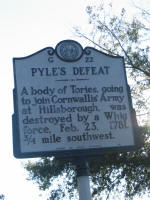 Pyle's Massacre -
February 23, 1781 - (my maternal Pyle's Massacre -
February 23, 1781 - (my maternal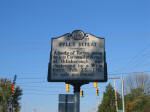 6th Great Grandfather) 6th Great Grandfather)
The following was written by written by Dr. George
Troxler of Elon University.
In the fall of
1778 Sir Henry Clinton, the British commander in America, having failed
to defeat Washington's army in the North and encouraged by reports of
southern loyalism, decided to pen a major offensive in the South.
He was successful at first. The British capture of Savannah in
December was followed by the restoration of royal rule of Georgia.
On May 12, 1780, Charleston and the entire southern army commanded by
Benjamin Lincoln surrendered to Clinton, In June Clinton returned
to New York, leaving Lord Charles Cornwallis in command with orders to
complete the conquest of the Carolinas.
After Lincoln's surrender at Charleston
the Continental Congress reorganized the Southern Department and gave
the command to General Horatio Gates, the hero of Saratoga. In
August 1780 Gates advanced toward the British outpost at Camden, South
Carolina. the Southern Department and gave
the command to General Horatio Gates, the hero of Saratoga. In
August 1780 Gates advanced toward the British outpost at Camden, South
Carolina. 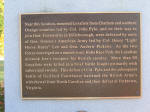 Cornwallis anticipated his move and on August 16 Gates
was surprised by the entire British army. Gates' "northern laurels
had turned to southern willows" and the southern army again was
decimated. Gates lost eight hundred killed and about one thousand
captured - nearly two thirds of his army. Congress relieved Gates
of his command. General Nathaniel Greene, Washington's' personal
choice to succeed Gates, took command of the remnants of the southern
army at Charlotte on December 2, 1780. Faced with a critical
shortage of supplies, Greene divided his numerically inferior force (violating
a basic rule of Military strategy) and so enabled the two smaller forces
to live off the land more easily. Greene sent one division under
Brigadier-General Daniel Cornwallis anticipated his move and on August 16 Gates
was surprised by the entire British army. Gates' "northern laurels
had turned to southern willows" and the southern army again was
decimated. Gates lost eight hundred killed and about one thousand
captured - nearly two thirds of his army. Congress relieved Gates
of his command. General Nathaniel Greene, Washington's' personal
choice to succeed Gates, took command of the remnants of the southern
army at Charlotte on December 2, 1780. Faced with a critical
shortage of supplies, Greene divided his numerically inferior force (violating
a basic rule of Military strategy) and so enabled the two smaller forces
to live off the land more easily. Greene sent one division under
Brigadier-General Daniel
 Morgan into northwest South Carolina. The
main army, under Greene, went into a "camp of repose" on the Pee Dee
River. As Morgan's location threatened the British garrison at
Ninety Six, Lord Cornwallis dispatched troops under Banastre Tarleton to
destroy Morgan's forces. At Cowpens on Broad River Morgan won a
surprising victory over Tarleton's troops on January 17, 1781. Morgan into northwest South Carolina. The
main army, under Greene, went into a "camp of repose" on the Pee Dee
River. As Morgan's location threatened the British garrison at
Ninety Six, Lord Cornwallis dispatched troops under Banastre Tarleton to
destroy Morgan's forces. At Cowpens on Broad River Morgan won a
surprising victory over Tarleton's troops on January 17, 1781.
Determined to recapture Morgan's prisoners and destroy his army,
Cornwallis joined Tarleton in pursuit of Morgan's small force.
Green quickly effected a junction of the American forces at Guilford
Courthouse and then continued the retreat across the Dan River into
Virginia where he could safely build up the American army.
Cornwallis, drawn dangerously further from his South Carolina bases,
halted at Hillsborough where he consoled himself by proclaiming the
liberation of North Carolina and calling on loyal subjects to join his
army.
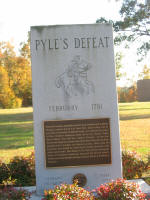 Dr. John Pyle, Sr.,
a native of
Chatham County, responded to Cornwallis's appeal. Pyle had been a
leader of the Regulator movement. There is no record of his
presence at the Battle of Alamance - but after the battle Governor
William Tryon requisitioned six wagon loads of flour from Pyle and other
residents of Cane Creek community.1 In 1775 Pyle
received a royal commission and led a company of loyal backcountry
militia at Moore's Creek Bridge. Along with his son, John Pyle,
Jr., he was captured by the patriots and imprisoned at Halifax.
The Pyle's and other prisoners whose presence in North Carolina
endangered the Revolutionary movement were sent by the Provincial
Congress to Virginia or Philadelphia. While being transported
north the Pyle's escaped and returned to Chatham County.2 Dr. John Pyle, Sr.,
a native of
Chatham County, responded to Cornwallis's appeal. Pyle had been a
leader of the Regulator movement. There is no record of his
presence at the Battle of Alamance - but after the battle Governor
William Tryon requisitioned six wagon loads of flour from Pyle and other
residents of Cane Creek community.1 In 1775 Pyle
received a royal commission and led a company of loyal backcountry
militia at Moore's Creek Bridge. Along with his son, John Pyle,
Jr., he was captured by the patriots and imprisoned at Halifax.
The Pyle's and other prisoners whose presence in North Carolina
endangered the Revolutionary movement were sent by the Provincial
Congress to Virginia or Philadelphia. While being transported
north the Pyle's escaped and returned to Chatham County.2
On December 13, 1776, Pyle appeared before the provincial Congress, took
an oath of loyalty to the state, and - upon giving bond - was permitted
to remain in the state3.
The proximity of Cornwallis's army
rekindled Pyle's Loyalist sentiments. In January and February of
1781 he raised three or four hundred loyalists between Haw and Deep
rivers and sent Cornwallis a request for an escort to Hillsborough.
Cornwallis detached Tarleton with his cavalry and a small body of
infantry with instructions to rendezvous with Pyle at a plantation a few
miles from Hillsborough.4
Greene had not left North Carolina
uncontested. His elite cavalry commanded by Henry Lee and militia
commanded by Brigadier-General Andrew Pickens (the latter comprised
primarily of North Carolinians) has recrossed the Dan to harass the
enemy. On February 23 Pickens and Lee joined forces and moved
toward the Haw fields area, having learned that the British
sympathizers there were preparing to send supplies to Cornwallis.
By scouts and informants they learned of Tarleton's movement and his
object - rendezvous with Pyle's forces.5
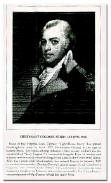 The forces of Lee and Pickens were
smaller than a combination of the British and loyalists. The
patriot commanders planned to prevent a junction between Tarleton and
Pyle. Their chief object was Tarleton's dragoons and regulars, the
loss of which would be a severe blow to Cornwallis's army. The forces of Lee and Pickens were
smaller than a combination of the British and loyalists. The
patriot commanders planned to prevent a junction between Tarleton and
Pyle. Their chief object was Tarleton's dragoons and regulars, the
loss of which would be a severe blow to Cornwallis's army.
On the afternoon of the twenty-fourth
Lee and Pickens were hastening west along the "Great Road" from
Hillsborough. At noon they had captured two British staff
officers; their interrogation revealed that Tarleton was a few miles
ahead. He planned to camp at a plantation only six miles from the
spot where the British offices were captured at noon6.
The sun was low in the February sky
when Lee's Legion at the head of the American forces met two of Pyle's
men. The loyalists tragically mistook Lee's Legion, clad in short
green jackets and plumed helmets, for Tarleton's dragoons who wore
similar attire. Lee made most of the deception and upon engaging
the loyalists in conversation found that Pyle, who was in the road just
ahead, had sent them forward to locate Tarleton's camp.7 Lee
finding the loyalists completely deceived - even mistaking him for
Tarleton - sent one of them back to Pyle.
Within minutes Lee's
Legion - their swords drawn in salute - were trotting along the line of
loyalists who had obligingly moved off the narrow road. Lee passed
along the line at the head of his column till "At length he reached
Colonel Pyle, when the customary civilities were promptly
interchanged."9 As Lee grasped Pyle's hand the sounds of battle at
the end of the column prevented further theatrics.
There are two varying
accounts of how the fighting began. Most early historians follow
the account given by Lee in his Memoirs published in 1812.
According to Lee's published account he planned to make known to Pyle
"his real character as soon as he should confront him, with a solemn
assurance of his and his associates perfect exemption from injury, and
with the choice of returning to their homes, or of taking a more
generous part by uniting with the defenders of their common country
against the common foe." Pickens' militia were to remain concealed
until Lee's cavalry were sure of their advantage over the deceived
Tories.
Firing commenced,
according to Lee, when some of the loyalists discovered Pickens' militia
and opened fire on Lee's rear guard of mounted North Carolina militia.
Captain Joseph Eggleston, a continental officer assigned to the rear
guard, responded by leading the attack on the Tories.
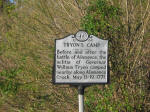 A second account pieced
together from Lee's report to Greene the following day and the account
of Captain Joseph Graham written after 1820 is accepted by most
historians today. Lee reported to Greene that he and Pickens hoped
to bypass the loyalists and surprise Tarleton, the more important
objective, encamped two or three miles beyond.10 A second account pieced
together from Lee's report to Greene the following day and the account
of Captain Joseph Graham written after 1820 is accepted by most
historians today. Lee reported to Greene that he and Pickens hoped
to bypass the loyalists and surprise Tarleton, the more important
objective, encamped two or three miles beyond.10
If Lee did in fact intend to bypass the Tories, the suddenness of the
encounter prevented his informing his officers of the scheme. The
local mounted militia at the rear of Lee's Legion, recognizing the
strips of red cloth on the hats of Pyle's men as the badge of loyalists,
alerted their commander, Captain Eggleston. Eggleston, like the
continental troopers in front of him, was new to the South and
unfamiliar with local Whig and Tory badges. He immediately
questioned one of the other group. "Who do you belong to?"
When the man answered "To King George," Eggleston struck him on the head
with his sabre.12 The Militiamen quickly joined their leader in
the attack. The terrified loyalists, certain that they were
victims of a horrible mistake, repeatedly identified themselves as
friends of His Majesty - but to no avail. In ten minutes the
battle was over and the surviving loyalists had fled.
Rather than pursue the
survivors, Lee and Pickens reformed their troops and pressed on towards
Tarleton's camp. The Americans encamped that evening with their
advance sentinels in sight of the British forces. The patriot
commanders decided to postpone battle until morning because it was dark
when they arrived and their men were tired from the long march and the
encounter with Pyle. By morning it was too late. During the
night an express from Cornwallis arrived at Tarleton's camp ordering his
immediate return to the main army. Greene had recrossed the Dan
and Cornwallis, tormented by visions of another Cowpens, was taking no
chances. During the night Tarleton broke camp and eluded the
American forces who pursued him in the early morning hours to the banks
of the Haw River - too close to the main British army for an American
attack.
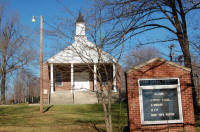 Casualty figures document the
identification of Pyle's defeat as a "massacre," Lee and Pickens
suffered only one casualty - a horse. Captain Joseph Graham, a
North Carolina militia officer with Lee, reported that his men counted
ninety-three dead on the battlefield the next morning. He saw
evidence of more being carried away by their friends. Certainly
many more were wounded. According to local legend, John Pyle, who
was badly wounded in the battle, crawled into a nearby pond where he
concealed himself until he could be rescued by his friends.14
After recovering from his wounds Pyle and his son surrendered to the
local militia. Later they were pardoned as a result of Pyle's care
for wounded patriots.15 Casualty figures document the
identification of Pyle's defeat as a "massacre," Lee and Pickens
suffered only one casualty - a horse. Captain Joseph Graham, a
North Carolina militia officer with Lee, reported that his men counted
ninety-three dead on the battlefield the next morning. He saw
evidence of more being carried away by their friends. Certainly
many more were wounded. According to local legend, John Pyle, who
was badly wounded in the battle, crawled into a nearby pond where he
concealed himself until he could be rescued by his friends.14
After recovering from his wounds Pyle and his son surrendered to the
local militia. Later they were pardoned as a result of Pyle's care
for wounded patriots.15
The British were quick to denounce the
American massacre of Pyle's loyal militia. Cornwallis, in a letter
to Lord George Germain, reported that most of Pyle's force were
"inhumanly butchered, when begging for quarters, without making the
least resistance."16 In the History attributed to Charles Stedman,
Cornwallis's civilian commissary, the author repeats the charge that the
Americans refused quarter to Pyle's men. "Humanity shudders," the
author wrote, "at the recital of o foul a massacre."17
Tarleton in his memoirs wrote of the
"inhuman barbarity" of the patriots when the loyalists "supplicated for
mercy."18
In his Memoirs Lee felt compelled "to
repel the unfounded stigma attached to the officer and Corp engaged with
Col Pyle."19 Lee stated that the loyalists attacked first.
Captain Joseph Graham, who commanded mounted cavalry at the rear of the
column where the fighting began, provided the account of Captain
Eggleston's attack on Pyle's men. Historians have accepted
Graham's account. Probably Lee was correct in stating that "less
than ninety could not have been spared from the close condition of the
dragoons and the necessity of crushing resistance instantly."20
The suddenness of the attack, the chaos which prevailed along the long
narrow column, and the loyalists' loaded weapons left the Legion little
choice. An orderly surrender was impossible.
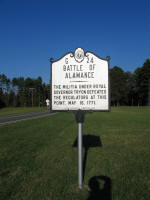 While later writers were somewhat
critical of Lee, his action was applauded at the time. The patriots were
embittered by the carnage and horrors of what had been a civil war in
the South. They had been incensed by Tarleton's massacre of
Abraham Buford's continentals at Waxhaws in northern South Carolina.
(Tarleton's corps, composed of American loyalists, had ignored Buford's
white flag and his men's please for quarter.) Whigs openly spoke
of granting "Tarleton's quarters" to fellow Americans who joined the
British. While later writers were somewhat
critical of Lee, his action was applauded at the time. The patriots were
embittered by the carnage and horrors of what had been a civil war in
the South. They had been incensed by Tarleton's massacre of
Abraham Buford's continentals at Waxhaws in northern South Carolina.
(Tarleton's corps, composed of American loyalists, had ignored Buford's
white flag and his men's please for quarter.) Whigs openly spoke
of granting "Tarleton's quarters" to fellow Americans who joined the
British.
In 1781 the war was still a contest
for the support of the local population. Pyle's defeat, although
only a large skirmish, had far-reaching implications. Cornwallis
was depending upon the enlistment of a large number of loyalists.
In weeks prior to the battle of
Guilford Courthouse, he looked in vain for recruits. Pyle's defeat
and Tarleton's mistaken slaughter of a smaller party of loyalists a few
days later were the death-blows to active loyalist allegiance in the
piedmont.
|
John Pyle
and Sarah Baldwin the following children: (Sarah is not mentioned in
her husband's will, so it is presumed she died before the will was drawn.)
|
i. |
Ann Pyle |
|
ii. |
Jehu Pyle,
married Ruth Lindley August 8, 1786. Ruth was born January 7,
1768. |
|
iii. |
Edith Pyle |
|
iv. |
Susannah
Pyle, married a Justice. |
|
v. |
James Pyle |
|
vi. |
Joseph Pyle |
|
vii. |
Sarah
Pyle (1750-1829) OUR
LINE |
|
viii. |
John Pyle,
(Dr.) married Sarah Brashear about 1770. This couple moved to
SC. It appears the move from NC to SC occurred about 1784.
About 1793, the John Pyle family moved on to the new state of
Kentucky, settling in Christian County, and his
brother Nicholas with his family also migrated to Christian County
from South Carolina at the same time. (So did Sarah, below). |
|
ix |
Mary Pyle, married John
Hall |
|
x |
Samuel Pyle, I don't think
he is mentioned in the will of Col. Pyle, but there is other evidence
that supports the kinship. I believe Samuel died in SC in 1787.
I am a descendent of Samuel Pyle and Jean Black, I have
been researching this line for the past 5 years following is some of
the info I have with regards to them:
WILL - CHRISTIAN CO., KY dated Mar 1806 and proved October Term 1807.
In the name of God, Amen I, Hans Black of the county of
Christian and state of Kentucky being very sick and weak in body but
of perfect mind and memory thanks be unto God, and calling unto mind
the mortality of my body and knowing that it is appointed for all men
once to die, do make and ordain this my last will and testament
disdaining all and every other will or wills that may have been made
by me heretofore that is to say principally and first of all, I give and recommend my soul to God and my body I
recommend to the earth to be buried in decent Christian manner at the
discretion of my executors and as touching such worldly estate where
with it has pleased God to bless me in this life. I give demise and
dispose of the same in the following manner and form in premises.
First I give and bequeath unto my dear and loving
wife Agnes Black all my whole estate during her lifetime.
Item I give and bequeath unto my son David Black the sum of ten
Dollars.
Item I give and bequeath to my son Thomas Black two hundred acres of
land.
Item after the decease of my wife Agnes Black it is my will that all
the estate and property that may then remain together with the
remainder of my land to be sold at public auction and the money
equally divided among the following persons, my son Jacob Black my
daughter Susannah Edwards my daughter Ann Pyle my son Thomas Black my
daughter Sarah McAlroy my daughter Elizabeth Brasier my daughter Jean
Pyle and my grandson Nicholas Pyle son of Samuel Pyle.
I am lastly do constitute and appoint my wife Agnes
Black and my son Thomas Black to be whole and sole executors to this
my last will and testament. I have here unto put my hand and sign this
date March 1806.
Hans (X) Black
Proved October Term 1807
I am also researching very hard on this family line right now for Hans
Black b:1720 Holland & his children. To update anyone, Ann Black,
daughter of Hans Black was married to Nicholas Pyle and they had 15
children. Nicholas & his brother, Samuel Pyle were the sons of Col. &
Dr. John Pyle of Chester Co., PA & his wife, Sarah Baldwin also of
Chester Co. They migrated to Chatham Co., NC; later some of the Pyle
families going to Christian Co., KY.
Samuel Pyle was married to Jean Black, another dau
of Hans Black. Also another dau of Hans was Elizabeth Black who
married Lawrence Brashier. They lived in Christian Co and raised their
family there. There is another son of Hans named Thomas Black; not to
be confused with David J. Black, Sr.'s son Thomas who married Thalia
Seaborn in 1809. David's brother Thomas was also speculating and
buying land in KY as well as David & the other brothers, John P. and
William. If anyone connects to these lines, would love to hear from
you as some solid evidence is being found now in SC, NC & KY as well
as AR, MO & IL.
Sue Meinhart (suemeinhrt@aol.com)
Samuel Pyle (son of John Pyle MD & Sarah Baldwin) & Jean had a son
named Nicholas who married Mary ? and they had 7 children including
Edwin, Polly, Jincy, Benjamin, John F, Elizabeth, Sarah. Edwin is my
g-g-g grandfather A cousin from Dallas and I
have been working on the parents for Samuel Pyle (married Charity
Eason) and his brother, John Pyle (married Mary Maxwell) for several
months and have come to the conclusion within a Preponderance of
Evidence that it was Samuel Pyle, son of Col. John Pyle of North
Carolina.
Here is a brief synopsis of our findings. If you would like more
proof, let me know.
Samuel Pyle was born in 1748 in Chester Co., PA. He was the son of
John Pyle and Sarah Baldwin. We found no marriage record for him but
did find that he died in testate in Greenville Co., SC. in 1787. The
Administrative Bond was signed by Mary A. Pyle, Hans Black and Jacob
Black. The Letter of Administration was signed by Mary Pyle,
Aquilla Brazier, John Brazier (both married into Col. John's and or
Hans Black's family).
On 26th Jan 1790, 640 acres of land in 96 District was put in Trust
of John Pyle, Jr. (another son of Col. John) for the children of
Samuel Pyle, dec'd. Nothing of Mary Pyle could be found after
the settlement of Samuel's estate, we presumed she died as she
wasn't mentioned in her father's will dated March 1806.
The Estate settlement of James Maxwell of Greene Co., Georgia lists
John Pyle of Greenville, South Carolina as Executor. This was dated
4 Dec 1797.
In Dorothy Holland Herring's research "Pyle-Pile of Georgia" stated
that Samuel and John Pyle came to Oglethorpe Co., Georgia in the
late 1790's from South Carolina.
One of our family member's DNA matched 100% with known descendants
of the
Pyles of Bishops Canning, England.
If you like more information, I'd be happy to send you and
attachment.
Doris |
From my cousin
Larry:
Col. Dr. John Pyle and his wife Sarah (Baldwin) had at least one additional
child not mentioned in the information sent to me. This was their 4th child,
MARY, born 02/08/1755 Pennsylvania. John Hall and Mary
Pyle married in 1776, near Philadelphia, Pennsylvania.
That Mary (Pyle) Hall is not mentioned in her fatherís will dated June 13,
1790, has been problematic for some. One reason for this may be due to the
fact that her husband, John Hall, Esq. (b. 04/15/1749 PA.) was a wealthy
land owner and quarry owner-operator. John and Mary Hall had 8 known
children, Samuel Hall being their eldest.
John Hall died 05/25/1836 in Ramsey, Fayette Co., Illinois and is interred
in Bolyard Cemetery (previously Hall Cemetery), Fayette Co., Illinois. His
wife, Mary (Pyle) then went to lived with their eldest son, Samuel Hall (b.
02/08/1777 Haw River, Chatham, NC) in Shelby Co., Illinois for an additional
10 years. Mary (Pyle) Hall died on 08/12/1846 and is interred in Ridge
Cemetery, Shelby Co., Illinois with a number of Hall family members.
John Hall is found with wife Marty (Pyle) and children in 1790 Census for
Hillsborough Dist., Chatham Co., NC. In the 1830 Census for Ramsey, Fayette
Co., IL., he, Mary and children are again found.
Anyway... I have a lot on them. Also, other lines such as: Lindley,
Hinds, Eckard...some quite distinguished lines.
Note: To begin with,
the Will of John Pyle recorded in Chatham County, NC a portion of it is
quoted as "my sons Parlientor, Daniel/Samuel/???? John ----" the hand
written copy looks more like "Particular named John -----" this is what the
famous 'Pyle Book' has.
The information most accepted for Samuel is b 1756 d 1801 Orange Co. NC -
but, this is based on a will recorded in Orange Co. that mentions family
members that are not shown elsewhere - brother-in-law John Hall and brother
Joseph. One abstract book claims this should have been 'Samuel Pike'. Samuel
Pike is found on the census and Samuel Pyle is not. An Elizabeth Pike
married a John Hall. There were 5 'John Halls' on the census at this time in
that area.
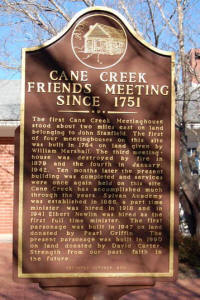 Land records show that Col John Pyle transferred land to his sons ca. 1784
before they left for SC and Georgia. Transactions are recorded for John Jr,
Samuel, Nicholas, William and his son's-in-law. Land records show that Col John Pyle transferred land to his sons ca. 1784
before they left for SC and Georgia. Transactions are recorded for John Jr,
Samuel, Nicholas, William and his son's-in-law.
Court records after the death of Col. John when Jehu brought suit against
the executors of the estate for having him buy land his father intended to
give him, named the sons and Samuel is included. Samuel and Nicholas are
referred to as "older sons"
In Greenville, SC a Samuel Pyle died in 1787 without a will, Mary A. Pyle is
the administrator (this could imply she was his widow, but is not stated)
the bond was signed by Hans Black and Jacob Black. Hans had a
daughter named Mary, as well as Jean and Ann who married Pyle's. Also, in
Christian Co. KY 1806 Will, Hans Black names his grandson, Nicholas Pyle son
of Samuel Pyle.
Hans does not name Nicholas's mother. Along with his other children he named
Ann Pyle and Jean Pyle, no mention is made of Mary Pyle, perhaps she was
deceased and he left her share to Nicholas.
John Pyle was given the authority to look out for the interest in land in SC
for the children of Samuel Pyle, dec'd, dated March 1790. Samuel was not
mentioned in Col. John Pyle's will because he was deceased.
My research is to find records naming the other children of Samuel Pyle.
While looking in the SC books at the library, I found the information about
John Lindley's death.
Sixth Generation
Sarah
PYLE.
Born on 10 Nov 1750 in Hartford County, Maryland. We don't know when she
died, but in Christian County court records, I forget which year, but she
was selling land in preparation to move. I am almost positive she
moved north to IL with a few of her children and died there.
On 16 Mar 1768 when Sarah was 17,
she married John LINDLEY, son of Thomas LINDLEY & Ruth HADLEY,
in Orange Co., North Carolina. Born on 13 Nov 1747 in London Grove, Chester,
Pennsylvania. John died in Anderson County, South Carolina on 5 Jul 1798, he
was 50.
Sarah Pyle and John Lindley had the
following children and I descend from two of them:
|
i |
Simon LINDLEY b: 20 JAN 1769 in Orange County, NC |
|
ii |
William LINDLEY b: 5 OCT 1770 in Orange County, NC |
|
iii |
Elizabeth LINDLEY b: 26 SEP 1772 in Orange County, NC, twin |
|
iv |
Mary LINDLEY b: 26 SEP 1772 in Orange County, NC, twin |
|
v |
John LINDLEY b: 26 SEP 1775 in Orange County, NC |
|
vi |
James LINDLEY b: 29 MAR 1777 in Chatham County, NC |
|
vii |
Thomas LINDLEY b: 22 APR 1779 in Chatham County, NC, married
Elizabeth Gibson. |
|
viii |
Jacob Marion LINDLEY b: 2 SEP 1781 in Chatham County, NC |
|
ix |
Jahu LINDLEY b: 9 NOV 1782 in Middletown New Castle County, Deleware |
|
x |
Ruth LINDLEY b: 17 FEB 1786 in Loudoun County, VA - married Isaiah
Crabtree.
The Crabtree is another of my lines, see the surname index. |
|
xi |
Samuel Washington LINDLEY b: 1788 in Anderson County, SC |
|
xii |
Jonathan LINDLEY b: ABT. 1790 in Anderson County, SC |
From here
see the Lindley Line and the Crabtree line.
|

